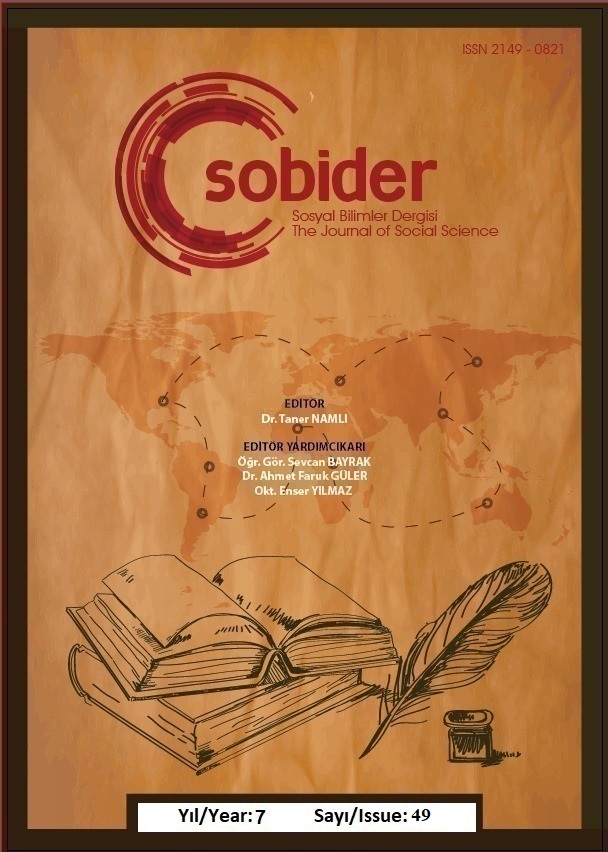Author :
Abstract
1960 ve 1980’lerde Türk sineması deyince akla Yeşilçam gelmektedir. Yeşilçam sineması halkın beğenisi ve isteklerine göre film çekerken estetik kaygı yaşamıyordu. Bu dönemde insanların yaşadıkları siyasal baskı ortamından bir film dakikası kadar rahatlamaları isteniyordu. Dünyada hâkim olan sinema kültürünü ve eğilimlerini de bu bakış açısına sahip olduğundan dolayı Türk sineması 1960 sonrası ve 80’lerin sonlarına kadar yakalamayı düşünememiştir. Bu dönemde insanlarımızın yaşadığı gerçek hayat olduğu gibi sinema dünyasının içine taşınması amaçlanmıştır. Toplumsal hayatın doğal gerçekliği içinde hiç kuşkusuz din çok önemli bir yer tutmaktadır. Bu durum din ve dinin yansıttığı düşünceler çerçevesinde ‘ imam’ temsilinde ortaya konmuştur. Kalıplaşmış din adamı temsili Türk sinemasında olumlu ve olumsuz tipleme olarak görülmüştür. Olumlu tipleme olarak; Cumhuriyeti temsil eden bıyıklı, modern giyimli, bakımlı ve bilgili olarak tasvir edilmiştir. Bir diğer yandan Olumsuz tipleme olarak da; Cumhuriyet karşıtı, ciddi duran, sakallı, bakımsız, modern giyim tarzını benimsemeyen, üçkâğıtçı, büyü yapan, muskacı, eğitimsiz olarak nitelendirilmektedir. Bu makalenin amacı Türk sinemasının 1960 ile 1980’ler’de ele alınan ‘Toplumsal Gerçekçi’ anlayışın din temasını sinemaya yansıtma biçimini ve Türk sinema tarihi içerisinde din adamı olgusunu farklı dönem, zihniyet ve yönetmen bakış açılarını temsil etmesi açısından ele almak ve bakış açılarına dini ve değerler faktörü açısından ‘Üçkâğıtçı’ filmi özelinde incelemektir. Makalemiz, filmin içerik çözülmesiyle elde edilecek verilerin dini değerler açısından değerlendirmesiyle sınırlıdır.
Keywords
Abstract
When we say Turkish cinema in the 1960s and 1980s, Yeşilçam comes to mind. Yeşilçam cinema had no aesthetic concernwhile filming according to the likes and desires of the public. In this period, people were asked to relax for a minute of a movie from the political pressure environment they experienced. Turkish cinema has not been able to catch up in the post-1960s and late 80s since it has this perspective, as well as the cinema culture and trends that dominate the world. In this period, it is aimed to move into the world of cinema as it is the real life of our people. Without doubt religion has an important place in the natural reality of social life. This has been demonstrated in the representation of 'imam' within the framework ofreligion and the thoughts reflected by religion. The stereotyped cleric representation has been seen as positive and negative typing in Turkish cinema. As positive typing; It is depicted as a mustache, modernly dressed, well-kept and knowledgeable, representing the Republic. On the other hand, as negative typing; He is described as anti-republic, serious standing, bearded, neglected, who does not adopt modern clothing style, trickster, making magics and amulets and uneducated. The aim of this article is to examine the way of reflecting the religious theme of the "Social Reality" approach of Turkish cinema, which was handled in the 1960s and 1980s, and the phenomenon of clergy in the history of Turkish cinema in terms of representing different periods, mentality and director perspectives, and toexamine the movie 'Üçkâğıtçı' specifically in terms of religion and values factor. Our article is limited to the evaluation of the data to be obtained by decoding the film in terms of religious values.
Keywords
- Agâh, Özgüç.(2005) .Türklerle Türk Sineması. İstanbul: Dünya Yayınları.
- Agâh, Özgüç.(2005) .Türklerle Türk Sineması. İstanbul: Dünya Yayınları.Andrey Tarkovski, Mühürlenmiş Zaman, Afasinema Yay. , İstanbul 1992. Ayşe Şasa, Delilik Üzerine Notlar, Gelenek Yy. İstanbul,2003.
- Berkes, Niyazi. (2013). Türkiye’de Çağdaşlaşma. İstanbul: Yapı Kredi Yayınları.
- Çiğdem, A. H. (2000). 1980 Sonrası Türk Sineması'nda Dinsel Temalar. Atatürk Üniversitesi
- Daldal, Aslı, 1960 Darbesi ve Türk Sinemasında Toplumsal Gerçekçilik, Homer Kitapevi, İstanbul, 2005.
- Feroz Ahmad, Modern Türkiye’nin Oluşumu, Kaynak Yy.1999
- Givanni Scognamillo, Dünya Sinema Sanayi, Timaş Yay. , İstanbul 1997 Göle, Nilüfer (2000). Melez Desenler. İstanbul: Ayrıntı, s.160.
- Hafızoğulları Zeki: İnsan Hakkı Olarak Kişilik Hakları ve Kişilik Haklarının Korunması, TRThttp://auhf.ankara.edu.tr/dergiler/ auhfd-arsiv/AUHF-1997-46-01-04/AUHF-1997-46- 01- 04-Hafizogullari.pdf (02.07.2014).
- Karakaya, Handan .(2008) . Türk Sinemasında Din Adamı Tiplemesi( Yayınlanmamış YüksekLisans Tezi) , Fırat Üniversitesi Sosyal Bilimler Enstitüsü Felsefe Din Bilimleri Ana Bilim Dalı Din Sosyolojisi Bilim Dalı, Elazığ.
- Lüleci, Y. (2009). Türk Sineması ve Din (Vol. 8). Es Yayınları.
- Nigar Pösteki, 1990 Sonrası Türk Sineması, Es Yay. , İstanbul 2005.
- Nilgün Abisel, Türk Sineması Üzerine Yazılar, Phoenix Yay. , Ankara 2005.Onaran A.Ş, Sinematografik Hürriyet, İçişleri Bakanlığı Yay. Ankara.
- Reşat Kasaba, Eski ile Yeni Arasında Kemalizm ve Modernizm, Tarih Vakfı Yurt Yay. Ryan Michael -Douglas Kellner, Politik Kamera, Ayrıntı Yay. , İstanbul 1997.
- Sadık Yalsızuçanlar, Rüya Sineması, Kırkambar Yay. , İstanbul 1998
- Şahmurat Arık, “Cumhuriyet Öncesi Türk Romanında Değerler Çatışması”, Hece, Say:65-66- 67, 2002.
- Şubası, Necdet.( 1996) , Türk Aydının Din Anlayışı, İstanbul: Yapı Kredi.
- Şükrü Hanioğlu, Osmanlı’dan Cumhuriyete Zihniyet, Siyaset ve Tarih, Bağlam Yy. 2009
- Y. Gürhan Topçu, “Karanlığın Kızları: Korku Sineması ve Kadın”, Sinemada Anlatı ve Türler, Vadi Yay. , Ankara 2004.
